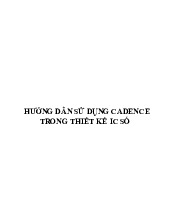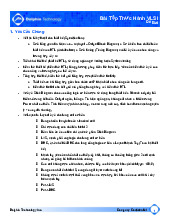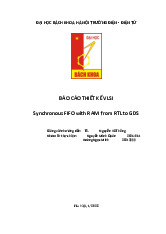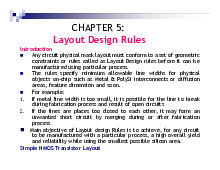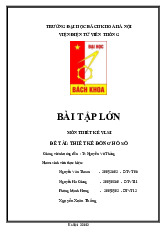



















Preview text:
LOSSLESS DATA COMPRESSION AND
DECOMPRESSION ALGORITHM AND ITS HARDWARE ARCHITECTURE
A THESIS SUBMITTED IN PARTIAL FULFILLMENT
OF THE REQUIREMENTS FOR THE DEGREE OF Master of Technology In
VLSI Design and Embedded System By V.V.V. SAGAR Roll No: 20607003
Department of Electronics and Communication Engineering
National Institute of Technology Rourkela 2008
LOSSLESS DATA COMPRESSION AND
DECOMPRESSION ALGORITHM AND ITS HARDWARE ARCHITECTURE
A THESIS SUBMITTED IN PARTIAL FULFILLMENT OF THE
REQUIREMENTS FOR THE DEGREE OF
Master of Technology In
VLSI Design and Embedded System By V.V.V. SAGAR Roll No: 20607003 Under the Guidance of Prof. G. Panda
Department of Electronics and Communication Engineering
National Institute of Technology Rourkela 2008
National Institute of Technology Rourkela CERTIFICATE
This is to certify that the thesis entitled. “Lossless Data Compression And
Decompression Algorithm And Its Hardware Architecture” submitted by Sri V.V.V.
SAGAR in partial fulfillment of the requirements for the award of Master of Technology
Degree in Electronics and Communication Engineering with specialization in “VLSI Design
and Embedded System” at the National Institute of Technology, Rourkela (Deemed
University) is an authentic work carried out by his under my supervision and guidance.
To the best of my knowledge, the matter embodied in the thesis has not been submitted to any
other University/Institute for the award of any Degree or Diploma.
Date: Prof.G.Panda (FNAE, FNASc)
Dept. of Electronics and Communication Engg.
National Institute of Technology Rourkela-769008 ACKNOWLEDGEMENTS
This project is by far the most significant accomplishment in my life and it would be impossible
without people who supported me and believed in me.
I would like to extend my gratitude and my sincere thanks to my honorable, esteemed
supervisor Prof. G. Panda, Head, Department of Electronics and Communication Engineering. He
is not only a great lecturer with deep vision but also and most importantly a kind person. I sincerely
thank for his exemplary guidance and encouragement. His trust and support inspired me in the most
important moments of making right decisions and I am glad to work with him.
I want to thank all my teachers Prof. G.S. Rath, Prof. K. K. Mahapatra, Prof. S.K.
Patra and Prof. S.K. Meher for providing a solid background for my studies and research
thereafter. They have been great sources of inspiration to me and I thank them from the bottom of my heart.
I would like to thank all my friends and especially my classmates for all the thoughtful
and mind stimulating discussions we had, which prompted us to think beyond the obvious. I‟ve
enjoyed their companionship so much during my stay at NIT, Rourkela.
I would like to thank all those who made my stay in Rourkela an unforgettable and rewarding experience.
Last but not least I would like to thank my parents, who taught me the value of hard work
by their own example. They rendered me enormous support during the whole tenure of my stay in NIT Rourkela. V.V.V. SAGAR CONTENTS
Abstract ...................................................................................................................... i
List of Figures ........................................................................................................... ii
List of Tables ............................................................................................................ iii
Abbreviations Used ................................................................................................. iv
CHAPTER 1. INTRODUCTION..........................................................................1
1.1Motivation…………………………………………………………..…....….2
1.2 Thesis Outline………………………………………………………..……..3 .
CHAPTER 2. LZW ALGORITHM……………………………………............4
2.1 LZW Compression………………………………………………...…..……5
2.1.1 LZW Compression Algorithm…………………………………..……7
2.2 LZW Decompression…………………………………………….…..……10
2.2.1 LZW Decompression Algorithm…………………………………..…11
CHAPTER 3 ADAPTIVE HUFFMAN ALGORITHM……………..……...…12
3.1 Introduction…………………………………………………………………13
3.2 Huffman‟s Algorithm and FGK Algorithm…………………………………15
3.3 Optimum Dynamic Huffman Codes……………………………………...…23
3.3.1 Implicit Numbering……………………………………………...……23
3.3.2 Data Structure…………………………………………………….……24
CHAPTER 4 PARALLEL DICTIONARY LZW ALGORITHM……………26
4.1 Introduction…………………………………………………………………27
4.2 Dictionary Design Considerations…………………………………….….…28
4.3 Compression Processor Architecture………………………….……………28
4.4 PDLZW Algorithm…………………………………………………………30
4.4.1 PDLZW Compression Algorithm…………………………………….30
4.4.2 PDLZW Decompression Algorithm……………………………….…33
4.5 Trade off Between Dictionary Size And Performance…………………….…35
4.5.1 Performance of PDLZW………………………………………….……35
4.5.2 Dictionary Size Selection………………………………………….…...37
CHAPTER 5 TWO STAGE ARCHITECTURE………………………..……..39
5.1 Introduction……………………………………………………….…….….40
5.2 Approximated AH Algorithm…………………………………….……..…40
5.3 Canonical Huffman Code………………………………………….………46
5.4 Performance of PDLZW + AHDB…………………………………..….…48
5.5 Proposed Two Stage Data Compression Architecture……………….….…49
5.5.1 PDLZW Processor……………………………………………..…….49
5.5.2 AHDB Processor…………………………………………….………50
5.6 Performance……………………………………………………………..…52
5.7 Results……………………………………………………………...…...….52
CHAPTER 6 SIMULATION RESULTS………………………………..….…54
CHAPTER 7 CONCLUSION…………………………………………..……...60
REFERENCES……………………………………………………………...…...62 Abstract
LZW (Lempel Ziv Welch) and AH (Adaptive Huffman) algorithms were most widely used for
lossless data compression. But both of these algorithms take more memory for hardware
implementation. The thesis basically discuss about the design of the two-stage hardware
architecture with Parallel dictionary LZW algorithm first and Adaptive Huffman algorithm in the
next stage. In this architecture, an ordered list instead of the tree based structure is used in the AH
algorithm for speeding up the compression data rate. The resulting architecture shows that it not
only outperforms the AH algorithm at the cost of only one-fourth the hardware resource but it is
also competitive to the performance of LZW algorithm (compress). In addition, both compression
and decompression rates of the proposed architecture are greater than those of the AH algorithm
even in the case realized by software.
Three different schemes of adaptive Huffman algorithm are designed called AHAT, AHFB and
AHDB algorithm. Compression ratios are calculated and results are compared with Adaptive
Huffman algorithm which is implemented in C language. AHDB algorithm gives good
performance compared to AHAT and AHFB algorithms.
The performance of the PDLZW algorithm is enhanced by incorporating it with the AH algorithm.
The two stage algorithm is discussed to increase compression ratio with PDLZW algorithm in first
stage and AHDB in second stage. Results are compared with LZW (compress) and AH algorithm.
The percentage of data compression increases more than 5% by cascading with adaptive
algorithm, which implies that one can use a smaller dictionary size in the PDLZW algorithm if the
memory size is limited and then use the AH algorithm as the second stage to compensate the loss
of the percentage of data reduction. The Proposed two–stage compression/decompression
processors have been coded using Verilog HDL language, simulated in Xilinx ISE 9.1 and
synthesized by Synopsys using design vision. List of Figures
Figure No Figure Title Page No.
Fig 2.1 Example of code table compression……………………………………………….…6
Fig 3.1. Node numbering for the sibling property using the Algorithm FGK…………………19
Fig 3.2 Algorithm FGK operating on the message “abcd ….. “……………………………..20.
Fig 4.1 PDLZW Architecture……………………………………………………………...….29
Fig 4.2 Example to illustrate the operation of PDLZW compression algorithm……………...33
Fig 4.3 Percentage of data reduction of various compression schemes……………………....36
Fig 4.4 Number of bytes required in various compression schemes……………………….…37
Fig 5.1 Illustrating Example of AHDB algorithm…………………………………………….42
Fig 5.2 Example of the Huffman tree and its three possible encodings……………………….46
Fig 5.3 Two Stage Architecture for compression……………………………………..………53
Fig 6.1 PDLZW output………………………………………………………………..…..….55
Fig 6.2 Write operation in Four dictionaries……………………………………………….…55
Fig 6.3 Dic-1 contents………………………………………………………………………...56
Fig 6.4 Dic-2 Contents………………………………………………………………………..56
Fig 6.5 Dic-3, 4 Contents……………………………………………………………………...57
Fig 6.6 AHDB processor Output……………………………………………………………...57
Fig 6.7 Order list of AHDB…………………………………………………………………...58
Fig 6.8 PDLZW+AHDB algorithm…………………………………………………………...58
Fig 6.9 AHDB decoder Schematic……………………………………………………………59 List of Tables
Table No. Table Title Page No.
Table 2.1 Step-by-step details for an LZW example …………………………………………..9
Table 4.1 Ten Possible Partitions of the 368-Address Dictionary Set…………………………38
Table 5.1 Performance Comparisons between AH Algorithm and It‟s……………………….44
Various Approximated Versions In The Case Of Text Files
Table 5.2 Performance Comparisons Between AH Algorithm and It‟s …………………........44
Various Approximated Versions In The Case Of Executable Files
Table 5.3 Overall Performance Comparisons Between the AH Algorithm………………….…45
And It‟s Various Approximated Versions.
Table 5.4 Canonical Huffman Code Used In the AHDB Processor………………………......47
Table 5.5 Performance Comparison of Data Reduction between ………………………….…51
COMPRESS, PDLZW + AH, PDLZW + AHAT, PDLZW + AHFB,
AND PDLZW + AHDB for Text files
Table 5.6 Performance Comparison of Data Reduction between ……………………….....…51
COMPRESS, PDLZW + AH, PDLZW + AHAT, PDLZW + AHFB,
AND PDLZW + AHDB for Executable files Abbreviations Used
LZW Algorithm Lempel Ziv Welch algorithm
AH Algorithm Adaptive Huffman Algorithm
PDLZW algorithm Parellel Dictionary LZW Algorithm
FGK algorithm Failer, Gallager, and Knuth Algorithm
AHAT Adaptive Huffman algorithm with transposition
AHFB Adaptive Huffman algorithm with fixed-block exchange
AHDB Adaptive Huffman algorithm with dynamic-block exchange Chapter 1 INTRODUCTION INTRODUCTION
DATA compression is a method of encoding rules that allows substantial reduction in the total
number of bits to store or transmit a file. Currently, two basic classes of data compression are
applied in different areas. One of these is lossy data compression, which is widely used to compress
image data files for communication or archives purposes. The other is lossless data compression
that is commonly used to transmit or archive text or binary files required to keep their information intact at any time. 1.1 Motivation
Data transmission and storage cost money. The more information being dealt with, the more it
costs. In spite of this, most digital data are not stored in the most compact form. Rather, they are
stored in whatever way makes them easiest to use, such as: ASCII text from word processors,
binary code that can be executed on a computer, individual samples from a data acquisition system,
etc. Typically, these easy-to-use encoding methods require data files about twice as large as
actually needed to represent the information. Data compression is the general term for the various
algorithms and programs developed to address this problem. A compression program is used to
convert data from an easy-to-use format to one optimized for compactness. Likewise, an
uncompression program returns the information to its original form.
A new two-stage hardware architecture is proposed that combines the features of both parallel
dictionary LZW (PDLZW) and an approximated adaptive Huffman (AH) algorithms. In the
proposed architecture, an ordered list instead of the tree based structure is used in the AH algorithm
for speeding up the compression data rate. The resulting architecture shows that it outperforms the
AH algorithm at the cost of only one-fourth the hardware resource, is only about 7% inferior to
UNIX compress on the average cases, and outperforms the compress utility in some cases. The
compress utility is an implementation of LZW algorithm. 2 INTRODUCTION 1.2 THESIS OUTLINE:
Following the introduction, the remaining part of the thesis is organized as under
Chapter 2 discusses LZW algorithm for compression and decompression.
Chapter 3 discusses the Adaptive Huffman algorithm by FGK and modified algorithm By JEFFREY SCOTT VITTER.
Chapter 4 discusses the Parallel dictionary LZW algorithm and its architecture.
Chapter 5 discusses The Two Stage proposed Architecture and its Implementation
Chapter 6 discusses the simulation results
Chapter 7 gives the conclusion. Chapter 2 LZW ALGORITHM
LZW compression is named after its developers, A. Lempel and J. Ziv, with later modifications by
Terry A. Welch. It is the foremost technique for general purpose data compression due to its
simplicity and versatility. Typically, we can expect LZW to compress text, executable code, and
similar data files to about one-half their original size. LZW also performs well when presented
with extremely redundant data files, such as tabulated numbers, computer source code, and acquired signals. 2.1 LZW Compression
LZW compression uses a code table, as illustrated in Fig. 2.1. A common choice is to provide 4096
entries in the table. In this case, the LZW encoded data consists entirely of 12 bit codes, each
referring to one of the entries in the code table. Decompression is achieved by taking each code
from the compressed file, and translating it through the code table to find what character or
characters it represents. Codes 0-255 in the code table are always assigned to represent single bytes
from the input file. For example, if only these first 256 codes were used, each byte in the original
file would be converted into 12 bits in the LZW encoded file, resulting in a 50% larger file size.
During uncompression, each 12 bit code would be translated via the code table back into the single
bytes. But, this wouldn't be a useful situation. code number translation 0000 0 0001 1 : : : : 0254 254 0255 255 0256 145 201 4 0257 243 245 : : 4095 xxx xxx xxx
FIGURE 2.1 Example of code table compression. This is the basis of the popular LZW
compression method. Encoding occurs by identifying sequences of bytes in the original file that
exist in the code table. The 12 bit code representing the sequence is placed in the compressed file
instead of the sequence. The first 256 entries in the table correspond to the single byte values, 0 to
255, while the remaining entries correspond to sequences of bytes. The LZW algorithm is an
efficient way of generating the code table based on the particular data being compressed. (The
code table in this figure is a simplified example, not one actually generated by the LZW algorithm).
original data stream: 123 145 201 4 119 89 243 245 59 11 206 145 201 4 243 245 . . . . .
code table encoded: 123 256 119 89 257 59 11 206 256 257 . . . .
The LZW method achieves compression by using codes 256 through 4095 to represent sequences
of bytes. For example, code 523 may represent the sequence of three bytes: 231 124 234. Each
time the compression algorithm encounters this sequence in the input file, code 523 is placed in
the encoded file. During decompression, code 523 is translated via the code table to recreate the
true 3 byte sequence. The longer the sequence assigned to a single code, and the more often the
sequence is repeated, the higher the compression achieved.
Although this is a simple approach, there are two major obstacles that need to be overcome:
(1) How to determine what sequences should be in the code table, and
(2) How to provide the decompression program the same code table used by the compression
program. The LZW algorithm exquisitely solves both these problems.
When the LZW program starts to encode a file, the code table contains only the first 256 entries,
with the remainder of the table being blank. This means that the first codes going into the
compressed file are simply the single bytes from the input file being converted to 12 bits. As the
encoding continues, the LZW algorithm identifies repeated sequences in the data, and adds them
to the code table. Compression starts the second time a sequence is encountered. The key point is
that a sequence from the input file is not added to the code table until it has already been placed in
the compressed file as individual characters (codes 0 to 255). This is important because it allows
the decompression program to reconstruct the code table directly from the compressed data,
without having to transmit the code table separately.
2.1.1 LZW compression algorithm 1
Initialize table with single character strings 2
String = first input character 3 WHILE not end of input stream 4 Char = next input character 5
IF String + Char is in the string table 6 String = String + Char 7 ELSE 8 output the code for String 9
add String + Char to the string table 10 String = Char 11 END WHILE 12 output code for String
The variable, CHAR, is a single byte. The variable, STRING, is a variable length sequence of bytes.
Data are read from the input file (Step 2 & 4) as single bytes, and written to the compressed file
(Step 8) as 12 bit codes. Table 2.1 shows an example of this algorithm.
CHAR STRING In Table ? Output Add to New Comments + CHAR Table STRING 1 t t t First character-no action 2 h th No t 256=th h 3 e he No h 257=he e 4 / e/ No e 258=e/ / 5 r /r No / 259=/r r 6 a ra No r 260=ra a 7 i ai No a 261=ai i 8 n in No i 262=in n 9 / n/ No n 263=n/ / 10 i /i No / 264=/i i 11 n in yes(262) in First match found 12 / in/ No 262 265=in/ / 13 S /S No / 266=/S S 14 p Sp No S 267=Sp p 15 a pa No p 268=pa a 16 i ai Yes(261) ai
Matches ai , ain not in table yet 17 n ain No 261 269=ain n ain added to table 18 / n/ Yes(263) n/ 19 f n/f No 263 270=n/f f 20 a fa No f 271=fa a 21 l al No a 272=al l 22 l ll No l 273=ll l 23 s ls No l 274=ls s 24 / s/ No s 275=s/ /
